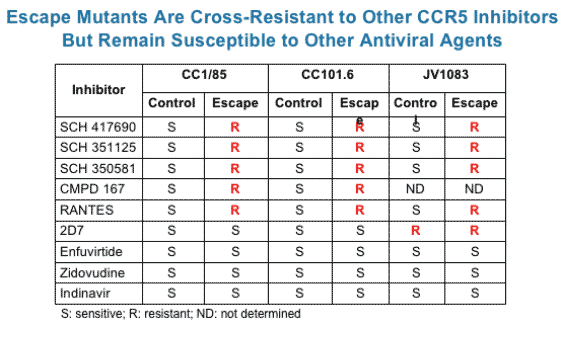 |
 |
 |
| |
Schering CCR5 Drug: Resistant viruses showed cross-resistance to other CCR5 inhibitors
|
| |
Reported by Jules Levin
"Properties of In Vitro Generated HIV-1 Variants Resistant to the CCR5 Antagonists SCH 351125 and SCH 417690 (Vicriviroc)"
Julie M. Strizki1, Lisa Wojcik1, Andre J. Marozsan2 Shawn E. Kuhmann2, Wei Huang3, Jeanette M. Whitcomb3, Christos Petropoulos3. John P. Moore2
1Antiviral Therapeutics, Schering-Plough Research Institute, Kenilworth, NJ 07033, USA. 2Weill Medical College of Cornell University, New York, NY, 3ViroLogic, Inc., South San Francisco, CA.
AUTHOR SUMMARY:
Resistance to CCR5 inhibitors emerges slowly in culture and is associated with the sequential accumulation of multiple mutations in gp120.
Resistant viruses generally remain CCR5-tropic in primary cells; CXCR4 tropic in primary cells; CXCR4-tropic variants were detected in one culture
Resistant viruses showed cross-resistance to other CCR5 inhibitors but were sensitive to other drug classes
Mutational patterns differed among individual resistant virus clones and were not always associated with V3-loop changes.
ABSTRACT
Introduction: Clinical development of small molecule CCR5 antagonists necessitates an understanding of the mechanism of HIV resistance to these molecules. We have investigated the in vitro development of resistance to two compounds, SCH 351125 (SCH-C) and SCH 417690 (SCH-D, vicriviroc), using different HIV isolates and cultures systems, characterizing the resistant variants phenotypically and genotypically.
Methods: HIV isolates were serially passaged in PM-1 cells or primary PBM Cs in the presence of increasing concentrations of SCH 351125 or SCH 417690; replication was monitored weekly by measurement of p24 antigen. Susceptibility was measured periodically in the cultures using primary cell infections or by generating pseudotyped reporter viruses harboring the gp160 sequences from treated or control cultures (PhenoSense assay). Viruses were further characterized for coreceptor tropism and cross-resistance to other antiviral compounds and CCR5 inhibitors. Sequence analysis was performed on envelope
clones from resistant cultures and in some cases recombinant viruses were tested for susceptibility to the compounds.
Results: Resistant viruses emerged in some but not all cultures after 12-16 weeks of continuous passaging. These viruses remained CCR5-tropic in primary cells and were unable to infect PBMCs from donors lacking functional CCR5. However, one isolate (D1/85.16) replicated in U-87-CXCR4 cells suggesting the presence of X4-tropic virus in the culture.
Clonal analysis of gp120 regions revealed that in most cases, an accumulation of mutations in the V3-loop correlated with a sequential decrease in sensitivity to CC R5 antagonists. Different viruses displayed unique patterns of V3 mutations although most were clustered in the V3 cap region. One resistant clone displayed no changes in V3 suggesting that other regions of gp120 may contribute to resistance. Infectivity studies demonstrated that highly resistant viruses replicate less efficiently than control viruses.
Summary: 1) Resistance to CCR5 inhibitors emerges slowly in culture and is associated with the sequential accumulation of multiple mutations in gp120. 2) Resistant viruses generally remain CCR5-tropic in primary cells; CXCR4-tropic variants were detected in one culture 3) Resistant viruses showed cross-resistance to other CCR5 inhibitors but were sensitive to other drug classes. 4) Mutational patterns differed among individual resistant viruses and were not always associated with V3-loop changes.
INTRODUCTION
Inhibiting the interaction of the viral envelope with the cellular coreceptors is
emerging as a promising strategy to treat HIV infection. Currently several small molecule CCR5 inhibitors including, SCH-351125 (SCH-C), SCH-417690 (vicriviroc, SCH-D) UK- 427,857 (maraviroc) and 873140 have progressed to clinical development. These molecules have proven to be effective in significantly reducing HIV plasma RNA levels when administered to patients in early phase trials.
As the clinical development of this class of molecules continues, it is important to
understand the mechanism by which resistance emerges and to identify the phenotypic and genotypic correlates associated with reduced susceptibility. CCR5 antagonists differ from other classes of inhibitors in that they target a cellular receptor, not a viral protein. Therefore, the pathway taken to achieve resistance to this class of compounds may differ somewhat from other inhibitors that act by binding directly to essential viral enzymes or proteins. Initial resistance studies performed with an early generation compound, SCH
350581 (AD101) revealed that resistance emerged over a period of about 16 weeks and was associated with 4 changes in the gp120 V-3 loop (Kuhmann, S.E.P. et al. 2004. J. Virol. 78:2790-2807). In the present study we have generated viral variants resistant to SCH 351125 and SCH 417690 by in vitro passaging and studied changes in compound susceptibility and gp120 sequences in treated and control cultures. As with the SCH 350581-resistant virus, our findings indicate that resistance emerges slowly and is associated a sequential accumulation of mutations in the viral envelope. However, the
position and clustering of the resistance-associated mutations within in the envelope does not follow a consistent pattern among different resistant clones and changes were not always observed in the V3 loop region.

| |
| |
| |
| |
|
 |
 |
|
|